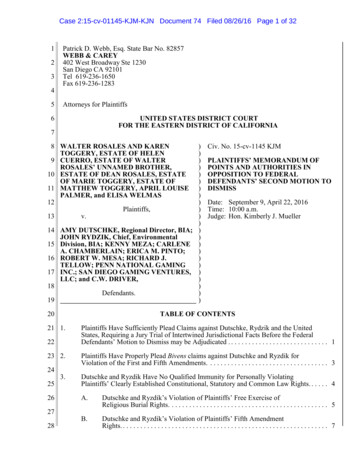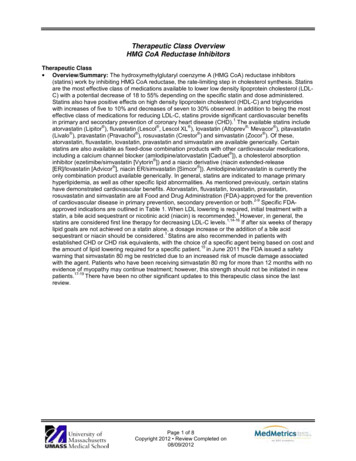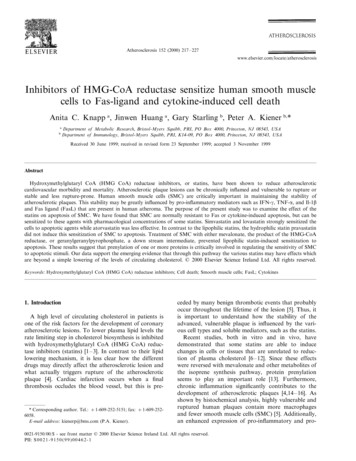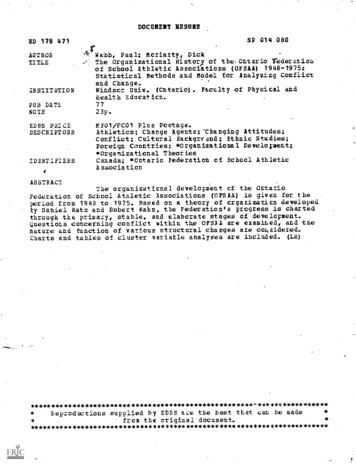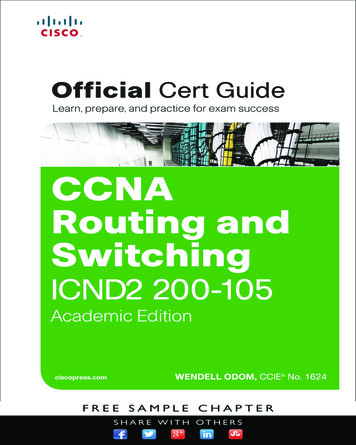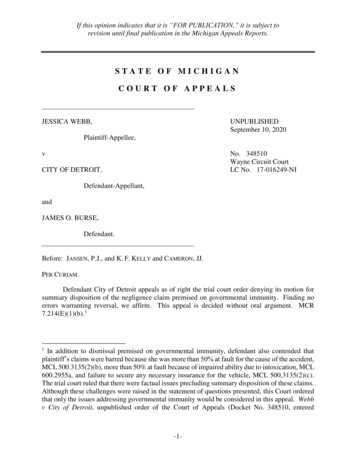
Transcription
If this opinion indicates that it is “FOR PUBLICATION,” it is subject torevision until final publication in the Michigan Appeals Reports.STATE OF MICHIGANCOURT OF APPEALSJESSICA WEBB,UNPUBLISHEDSeptember 10, 2020Plaintiff-Appellee,vNo. 348510Wayne Circuit CourtLC No. 17-016249-NICITY OF DETROIT,Defendant-Appellant,andJAMES O. BURSE,Defendant.Before: JANSEN, P.J., and K. F. KELLY and CAMERON, JJ.PER CURIAM.Defendant City of Detroit appeals as of right the trial court order denying its motion forsummary disposition of the negligence claim premised on governmental immunity. Finding noerrors warranting reversal, we affirm. This appeal is decided without oral argument. MCR7.214(E)(1)(b).11In addition to dismissal premised on governmental immunity, defendant also contended thatplaintiff’s claims were barred because she was more than 50% at fault for the cause of the accident,MCL 500.3135(2)(b), more than 50% at fault because of impaired ability due to intoxication, MCL600.2955a, and failure to secure any necessary insurance for the vehicle, MCL 500.3135(2)(c).The trial court ruled that there were factual issues precluding summary disposition of these claims.Although these challenges were raised in the statement of questions presented, this Court orderedthat only the issues addressing governmental immunity would be considered in this appeal. Webbv City of Detroit, unpublished order of the Court of Appeals (Docket No. 348510, entered-1-
I. BASIC FACTS AND PROCEDURAL HISTORYThis litigation arises from a chain reaction accident in which a city bus collided with avehicle that struck plaintiff who was standing nearby and suffered injuries. Specifically, inOctober 2017, plaintiff “shared” a Dodge Journey with her daughter Monica Webb. Afterspending the day running errands, plaintiff drove the vehicle to a local bar and consumed alcoholicbeverages. At approximately 3:30 a.m., she left the bar and drove on a four-lane road with twolanes in each direction. Plaintiff alleged that a vehicle driven by Devontae Wilson cut in front ofher in the left lane and caused her to drive into the right lane to avoid colliding with his vehicle.She claimed that Wilson suddenly turned right into a driveway from the left lane. Plaintiff declinedto state that she drove into or rear-ended Wilson’s vehicle, but claimed that the two vehiclescollided.Wilson, an emergency medical technician, testified that he drove northwest on Morang,turned right into his driveway, and was rear-ended. The rear passenger side of his vehicle wasstruck by the front end of the plaintiff’s vehicle. This caused his car to spin around two to threetimes, and it landed in his next-door neighbor’s yard, but facing the street. Plaintiff’s vehicle was“almost parked on the other side of the street facing the wrong way.” Wilson tried to talk toplaintiff, but she said that the accident was Wilson’s fault. The situation became “intense,” so hecalled the police. Wilson was on the phone with the police when the bus hit plaintiff’s car, but hedid not see the accident. He believed that the bus was traveling 35 or 40 miles per hour (mph) ina 30-mph zone because of the sound of acceleration. Wilson was “pretty sure” that the lights wereilluminated on plaintiff’s vehicle.Lenard Peterson was playing cards in a nearby home when he heard the sound of the firstaccident. He saw plaintiff get out of her vehicle as she spoke on the telephone. Peterson saw thatplaintiff was bleeding from her nose and offered to assist her. Plaintiff said that her family was onthe way. Peterson opined that plaintiff was having an exchange with the “three” men that wereinvolved in the accident, and he stayed nearby to ensure that no one harmed her. The area was “alittle dark,” despite the streetlights, and it was raining. Peterson heard a bus coming, but thoughtthere was enough room to maneuver around plaintiff’s vehicle. The bus was traveling “a littlefast” to be approaching an accident scene. Plaintiff was at the back of her vehicle, and Petersonsuggested that she step out of the way because of the bus. The bus did not reduce speed, and ithit plaintiff’s vehicle. Plaintiff’s vehicle struck her and knocked her “down the street” for “morethan 20 feet.” Peterson estimated that the bus was traveling 40 to 50 mph in light of his experience“driving for years.”Peterson thought that plaintiff’s vehicle was facing the direction in which the bus wascoming. Plaintiff’s vehicle was not straight, but “at like kind of a contorted angle” and waspartially in the street. Peterson thought the bus was traveling in its lane. He could not recall if theheadlights or hazard lights were on plaintiff’s vehicle. After the second accident, Peterson ran toplaintiff. He picked up her phone and told her family that she had been hit by a bus. The familyDecember 27, 2019) (“The Court orders that the motion to dismiss all non-governmental immunityclaims for lack of jurisdiction is GRANTED.”) Accordingly, only issues pertaining togovernmental immunity are addressed on appeal.-2-
arrived within a couple of minutes, picked her up, and took her to the hospital. James O. Burse,the bus driver, spoke to Peterson after the accident, and he was emotional and distraught becauseof plaintiff’s injury.Detroit Police Officer Richard Schwab investigated the accident and found that plaintiffwas involved in an accident with Wilson because of the heavy rear-end damage sustained to hisvehicle. Then, the bus accident occurred with plaintiff’s car, and plaintiff was struck by her car asshe stood outside it. Plaintiff was rendered incapacitated and immediately transported to thehospital. Because of her incapacity, Wilson provided the accident account. Additionally, OfficerSchwab’s investigation was hampered by plaintiff’s family who were “very difficult to deal with.”Ultimately, Officer Schwab reviewed the video taken from the bus and concluded thatBurse was a “possibly fatigued [driver] operating a bus striking the complainant’s vehicle” andher vehicle “was left to center.” There was functional damage to plaintiff’s vehicle. It wasunknown what damage was sustained as a result of the rear-end collision as opposed to the accidentwith the bus. Officer Schwab did not know if the headlights on plaintiff’s vehicle were operationalafter the first accident.His report also noted that Burse was tested for drugs and alcohol, and the results werenegative. It was concluded that Burse collided with plaintiff’s vehicle because of possible fatigue.With regard to the lighting, Officer Schwab acknowledged that it was dark in the area of theaccident, and it was raining at the time. Consequently, bus driver Burse was issued a ticket for theaccident.Burse acknowledged that he was given a ticket for fatigue arising from this accident, wentto court, pleaded no contest, and paid the ticket. At the court hearing, he recalled providing thefollowing factual summary about the accident:And I told them that it was - - like I say, it was raining hard and visibilitywas low. Like I say, I wasn’t speeding. And like I say, by the time I came uponthe vehicle there was no lights, no flashing emergencies or nothing. It was in theroad and I tried to avoid it, but there was a car coming in the other lane, and Icouldn’t avoid it and that’s when I struck that vehicle.Burse testified that, although there were streetlights in the area, the trees were “like up under thelight.” Additionally, it was “raining really hard and visibility was really low.”Burse disputed the statement in the police report that plaintiff’s vehicle was parked whenthe bus struck it. He noted that the vehicle was not properly parked, but was in the lane of trafficand at an angle. Additionally, the hazards and headlights were not on at the time. He explainedthat he came upon plaintiff’s vehicle protruding into the lane of travel and tried to take evasiveaction, but he could not travel into the other lane because a vehicle was approaching from the otherdirection. Although it was raining hard, he was not speeding in that area. The right side of thefront of the bus struck the left side of the front fender of plaintiff’s vehicle. Burse checked on thebus passengers, then became aware of plaintiff’s injury when he saw her lying on the ground.Burse was certain that plaintiff’s vehicle was obstructing the eastbound lane of traffic as hetravelled eastbound. Burse also testified that he was traveling under the speed limit because of the-3-
weather conditions, but he could not state his exact speed. He braked just before he came uponthe car, but when he applied the brakes, it was too late. Burse never saw plaintiff in the streetbefore the accident because it was “hard to see anything.” Burse denied that he fell asleep or dozedoff, but he acknowledged that he may have been fatigued. He began his shift at 7:00 p.m., and theaccident happened around 4:00 a.m. As a result of the accident, Burse received discipline of aone-day “retrain.” That is, he drove a shift while observed by another driver who evaluated hispatterns.Plaintiff’s medical records disclosed that her “ethanol percent” was “0.12% High.”Additionally, the bus was monitored by video equipment. However, there was no camera on thefront of the bus filming the roadway in front of the bus. Rather, the camera was placed above andbehind the Burse’s head.2 As the video progressed, various lighting was observed coming into thewindshield area. However, it could not be ascertained what the lighting was coming from, whetherit was a streetlight, a light from an oncoming vehicle, or a reflective light coming back toward thebus. There does not appear to be any lighting directed toward the bus just before the accident.However, defendant did present evidence that Burse was travelling 30 mph prior to the accident,contrary to the beliefs offered by Wilson and Peterson.Plaintiff filed suit against defendant city and bus driver Burse alleging negligence and grossnegligence for the failure to stop the bus in an assured safe distance, causing a collision betweenplaintiff and her vehicle. Defendants moved for summary disposition, contending that they wereentitled to governmental immunity from the acts of ordinary negligence. Specifically, it wasalleged that plaintiff drove her vehicle with a blood alcohol content above the legal limit andwithout the necessary insurance. After being involved in an accident with Wilson, plaintiff didnot comply with the legal requirement to remove the vehicle from the roadway, but allegedly leftthe vehicle running and without its lights on and facing the wrong direction.In light of this factual scenario, defendants contended that the claim of gross negligenceagainst Burse must be dismissed pursuant to MCL 691.1407(7) because the driver was engaged inthe course of his employment, defendant city was engaged in a governmental function (theoperation of a public transportation system), and the conduct did not rise to the level of grossnegligence that was the proximate cause of injury. Further, the camera did not show any lightilluminated on plaintiff’s vehicle before the accident. Accordingly, it was claimed that plaintifffailed to demonstrate the elements of negligence and Burse’s conduct was not “the” proximatecause of plaintiff’s injuries, and therefore, both defendants must be dismissed.Plaintiff filed a response in opposition to defendants’ motion for summary disposition. Itwas alleged that Burse was grossly negligent in his operation of the bus by failing to keep a lookoutfor road hazards and falling asleep. It was acknowledged that plaintiff was involved in an accidentwith Wilson. However, after this accident, her vehicle’s lights were on, and it was operational.As plaintiff spoke on the telephone to her family, the bus struck her vehicle “going full speed,”and that vehicle slammed into plaintiff. Additionally, other witnesses testified that plaintiff’svehicle was visible, and the bus was speeding. The police officer who investigated the accident2There was also a camera view of bus passengers entering the bus and the seating area of the bus.However, those views are not pertinent to resolution of the issues.-4-
observed the video from the bus and opined that it appeared that Burse was fatigued because headjusted in his seat, perhaps to stop himself from falling asleep.Plaintiff alleged that these facts demonstrated that Burse operated the city bus in a grosslynegligent manner, and therefore, defendants were responsible in tort liability. Specifically, grossnegligence was demonstrated by the investigating officer’s testimony that Burse appearedfatigued, and he failed to take evasive action to avoid plaintiff’s vehicle. This evidence alsoestablished that Burse was the proximate cause of plaintiff’s injuries. Regardless of the mannerand direction of plaintiff’s vehicle, driving the bus in a fatigued state without evasive action causedthe accident. Accordingly, defendant city was liable under the motor vehicle exception togovernment tort liability as well as arising from the gross negligence of Burse. This evidence ofgross negligence created factual issues regarding plaintiff’s fault and precluded summarydisposition of her claims.In reply, defendants highlighted that plaintiff acknowledged her vehicle was stopped “inthe road,” and she also failed to deny that her vehicle was facing the wrong direction and angledinto the lane of travel. Although plaintiff claimed that her vehicle’s headlights were on, the videofrom the bus demonstrates that there were no headlights or hazard lights visible to bus driver Burse.The video also shows that Burse was awake and responsive. Plaintiff could not rely on facts thatwere contradicted by the video evidence. Furthermore, even if it was assumed Burse fell asleep,caselaw holds that falling asleep at the wheel does not provide evidence of gross negligence.Consequently, defendants were entitled to summary disposition.The trial court heard oral argument on the motion and then ruled as follows:Gross negligence is defined within the GTLA as conduct so reckless as todemonstrate a substantial lack of concern for whether an injury results.An act is grossly negligent when an objective observer concludes the actorsimply did not care about the safety or welfare of those in charge.That’s Tarlea v CrabTree, 263 Mich App 80 (2004) case.Further evidence of ordinary negligence does not create a material questionof fact concerning gross negligence. That’s pursuant to Maiden v Rozwood, 461Mich 109.Rather to establish gross negligence the evidence must demonstrate that thecontested conduct was substantially more than negligent.Summary disposition on the issue of whether conduct constitute[s] grossnegligence is not appropriate if reasonable Jurors could honestly reach differentconclusions.However if reasonable minds could not differ the issue may be determinedby a Motion for Summary Disposition. That’s Oliver v Smith, 290 Mich App 678.-5-
While there’s a line of cases such as Boos v Sauer, 266 Mich 230 whichrecognize falling asleep, this is only where there is such prior warning of thelikelihood of sleep that continuing to drive constitutes reckless disregard of theconsequences.Thus a driver overcome by sleep or fatigue is not guilty of gross negligenceor wilful and wanton misconduct unless he continues driving in reckless disregardof premonition-type symptoms.After careful review of the entire record even viewing in the light mostfavorable to the non-moving Plaintiff no reasonable factfinder could conclude Mr.Burse’s actions constitute a reckless disregard or that it was substantially more thannegligent, he’s thus entitled to governmental immunity and any claims he getsindividually are dismissed as a matter of law under (C)(7) and (C)(10).Defendant’s [sic] motion is denied and [sic] other respects as this recordwhen viewed in the light most favorable to the nonmoving Plaintiff is replete withgenuine material and factual disputes upon which reasonable minds could differ.Including whether Mr. Burse was ordinarily negligent and if so to whatextent of fault Plaintiff was comparatively negligent, including whether and if so towhat extent of fault her intoxication contributed to the incident.And 3, genuine issues of material fact regarding proximate causation.So that’s the ruling of the Court.Thus, the trial court granted summary disposition of the claim alleging gross negligence pertainingto Burse, but denied defendant’s motion for summary disposition of the negligence claim. Plaintiffdid not appeal the dismissal of the gross negligence claim, and therefore, the appellate challengeis limited to whether the trial court erred in denying summary disposition of the negligence claim.II. STANDARD OF REVIEWA trial court’s ruling on a motion for summary disposition is reviewed de novo. Bennett vRussell, 322 Mich App 638, 642; 913 NW2d 364 (2018). Summary disposition is appropriatepursuant to MCR 2.116(C)(7) when the moving party is entitled to “immunity granted by law.”When reviewing a motion for summary disposition premised on immunity, this Court examinesthe affidavits, depositions, admissions and other documentary evidence to determine whether themoving party is entitled to immunity as a matter of law. Margaris v Genesee Co, 324 Mich App111, 115; 919 NW2d 659 (2018). The evidence is viewed in the light most favorable to thenonmoving party. Id.Summary disposition is appropriate pursuant to MCR 2.116(C)(10) where there is “nogenuine issue as to any material fact, and the moving party is entitled to judgment or partialjudgment as a matter of law.” MCR 2.116(C)(10). When reviewing a motion for summarydisposition challenged under MCR 2.116(C)(10), the court considers the affidavits, pleadings,depositions, admissions, and other admissible documentary evidence then filed in the action or-6-
submitted by the parties. MCR 2.116(G)(4), (G)(5); Puetz v Spectrum Health Hosp, 324 MichApp 51, 68; 919 NW2d 439 (2018).III. APPLICATION OF GOVERNMENTAL IMMUNITYDefendant alleges that the trial court improperly denied summary disposition premised onthe automobile exception to governmental immunity. We disagree.A. NEGLIGENT OPERATIONPursuant to the government tort liability act (GTLA), MCL 691.1401 et seq, governmentalagencies and their employees are entitled to immunity from tort liability when engaged in theexercise or discharge of a governmental function. Ray v Swager, 501 Mich 52, 62; 903 NW2d 366(2017). The only theory of liability challenged in this appeal is the automobile exception togovernmental immunity for claims of negligent operation of a motor vehicle pursuant to MCL691.1405. MCL 691.1405 states:Governmental agencies shall be liable for bodily injury and propertydamage resulting from the negligent operation by any officer, agent, or employeeof the governmental agency, of a motor vehicle of which the governmental agencyis owner, as defined in Act No. 300 of the Public Acts of 1949, being sections 257.1to 257.923 of the Compiled Laws of 1948. [MCL 691.1405.]MCL 691.1405 holds governmental agencies responsible for injury and damage resultingfrom an employee’s “negligent operation” of a motor vehicle. To establish a prima facie case ofnegligence, the burden of proof rests with the plaintiff to show that (1) the defendant owed a legalduty to the plaintiff; (2) the defendant breached the duty; (3) the plaintiff suffered damages; and(4) the defendant’s breach was a proximate cause of the damages sustained by the plaintiff. Hill vSears, Roebuck & Co, 492 Mich 651, 660; 822 NW2d 190 (2012).With regard to proximate cause, the Ray Court held as follows:Proximate cause is an essential element of a negligence claim. It involvesexamining the foreseeability of consequences, and whether a defendant should beheld legally responsible for such consequences. Proximate cause is distinct fromcause in fact, also known as factual causation, which requires showing that but forthe defendant’
JESSICA WEBB, Plaintiff-Appellee, UNPUBLISHED September 10, 2020 v No. 348510 Wayne Circuit Court . and failure to secure any necessary insurance for the vehicle, MCL 500.3135(2)(c). . Plaintiff alleged that a vehicle d
